All published articles of this journal are available on ScienceDirect.
In-House Preparation and Standardization of Herbal Face Pack
Abstract
Background:
Since the ancient times, there has been awareness among people regarding the use of plants for the essential needs of a healthy and beautiful skin. Cosmetics are the products used to clean, beautify and promote attractive appearance. Cosmetics designed via incorporating natural sources such as herbs have been proven very fulfilling, in coping up with the present needs of different skin types.
Objective:
As due to increased pollution, allergy, microbes etc, human skin has become more sensitive and prone to faster aging. An attempt has been made to synthesize a pack ideal for all skin types. After the synthesis, all the parameters have been calculated in order to meet up the quality standards.
Materials and Methods:
The constituents were extracted from herbal ingredients such as Multani mitti, green tea, saffron, gram flour, turmeric, shwet chandan and milk powder. They were purchased from the local area and were dried separately, grinded, passed through sieve no 40, mixed homogenously and then evaluated for parameters including organoleptic, physicochemical, rheological features, phytochemical, stability, and irritancy examination.
Results:
The dried powders of combined pack showed good flow property which is suitable for a face pack. Organoleptic evaluation showed that the pack is smooth and pleasant smelling powder. Rheological findings justified the flow properties of the pack as it was found to be free flowing and non-sticky in nature. The results proved that the formulation was stable on all aspects. Irritancy test showed the negative. Stability tests performed revealed the inert nature of the pack.
Conclusion:
Thus, in the present work, we formulated a pack, which can be easily made with the easily available ingredients. It showed all the benefits of a face pack and further optimization studies are required on its various parameters to find its useful benefits on the human beings.
1. INTRODUCTION
Since the ancient era, people are aware of the use of plants for the essential needs of a healthy and beautiful skin. Cosmetics are the products used to clean, beautify and promote attractive appearance [1]. Skin of the face is the major part of the body, which is a mirror, reflecting the health of an individual. A balanced nutrition containing amino acids, lipids and carbohydrates are required for the skin to keep it clear, glossy and healthy. In ancient times, women were very conscious about their beauty and took special care of their specific skin types [2]. Even today, people especially in rural areas, and hilly regions go for the natural remedies like plants extracts for various cosmetics purposes like neem, aloe vera, tulsi, orange peel, rose etc. Herbal cosmetics are the products which are used to purify and beautify the skin. The main advantage of using herbal cosmetic is that it is pure and does not have any side effects on the human body. Men have rough skin and when they don’t take sufficient care, then the skin turns dark due to overexposure to the sun, other pollutants etc [3]. In this article we have formulated homemade face pack to whiten, lighten and brighten the skin naturally for men and women. This face pack has natural skin lightening property and can be easily prepared at home [4]. Face packs with natural constituents are rich in vital vitamins that are essential for the health and glow of the skin. These substances have been proven to be beneficial for skin in many ways. Natural facial packs are easy to use. They increase the circulation of the blood within the veins of the face, thereby increasing the liveliness of the skin [5]. A good herbal face pack must supply necessary nutrients to the skin, available in the form of free-flowing powder applied facially for the external purpose. It should penetrate deep down the subcutaneous tissues to deliver the required nutrients. Every type of skin is specific for the requirement of skin pack. Nowadays different types of packs are available separately for the oily, normal and dry skin. Face packs are used to increase the fairness and smoothness of the skin. It reduces wrinkles, pimples, acne and dark circles of the skin [6]. Face packs which are recommended for oily skin prone to acne, blackheads, usually control the rate of sebum discharge from sebaceous glands and fight the harmful bacteria present inside acne lesion. The leftover marks of skin can be reduced by incorporation of fine powders of sandalwood, rose-petals and dried orange peels. Herbal face packs are nowadays being used on a large scale, due to the various benefits of them over chemical based packs. They are non-toxic, non-allergic and non-habit forming. They are natural in every aspect, having larger shelf lives. They have no added preservatives. They can be easily formulated and stored over a larger span of time. Present research article deals with the formulation and characterization of cosmetic herbal face pack made from natural constituents.
2. MATERIALS AND METHODS
The crude drugs used in this study were procured from the nearby local area. All the ingredients were washed, shade dried and powdered finely for further use. The following ingredients were used for the preparation of this polyherbal face pack formulation [7].
2.1. Multani Mitti OR Fuller's Earth
Fig. (1) multani mitti which helps to remove the impurities in the form of dead skin cells. It helps to make the skin radiant. It has been proven best for the irritation-prone skin. Its soothing action calms the skin, cures the inflammation caused due to elevated phlogistic agents. It is perfect for oily skin. It removes the dirt and excess of oil by acting as a perfect adsorbent. It provides fresh, radiant and glowing skin [8].
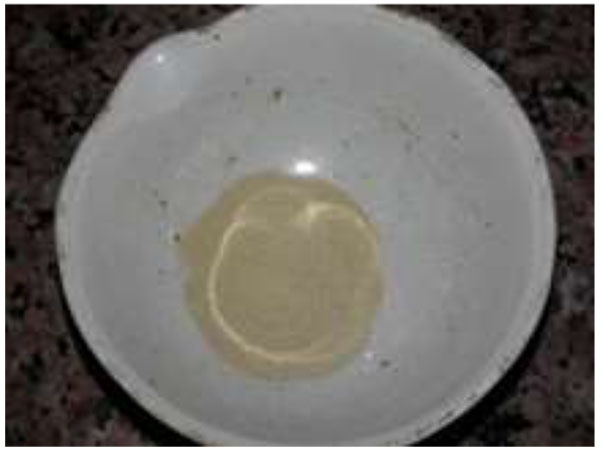
2.2. Haridra (Curcuma Longa)
Haridra in Fig. (2) has been used in this preparation due to its blood purifying property and helps in wound healing, because of its antiseptic action. It cures the skin diseases occurring due to blood impurities. It is a very good anti-inflammatory and anti-allergic agent. The phytoconstituents, mainly terpenoids present in it helps to lighten the skin tone. Haridra delays the signs of aging like wrinkles, improves skin elasticity. It cures pigmentation, uneven skin tone and dull skin [9].
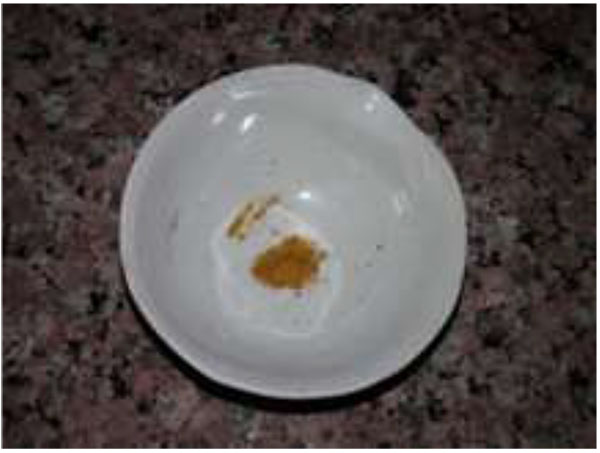
2.3. ShwetChandan (Santalum Album)
White Sandalwood powder in Fig. (3) is used to cure various skin allergies. It has cooling and soothing action. It protects the skin from environmental pollution and keeps it glowing, fair and healthy. Sandalwood possesses antimicrobial properties, therefore it is used to cure various skin problems and also removes scars, acne etc [10].
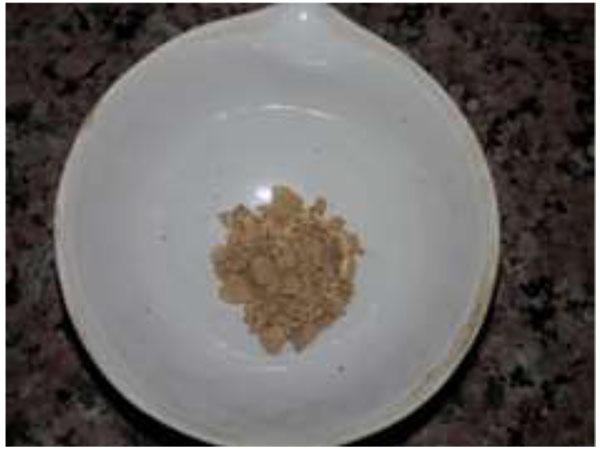
2.4. Green Tea
Belonging to the family Theaceae, green tea in Fig. (4) due to its rich phytoconstituents, serves for numerous therapeutic benefits. It slows down aging, reduces inflammation and provides a healthy glow [11].
2.5. Gram Flour
Gram flour, commonly known as Besan in Fig. (5), has been used extensively since the olden times for its beauty-enhancing benefits. It mainly acts as a tonic for the skin as it helps to clean and exfoliate it. Gram flour is nothing but a pulse flour obtained from grinded chickpeas. It is very beneficial for skin as well as hair. It is used to decrease tanning of the skin, also reduces the oiliness of skin, thus proving as a good anti-pimple agent. It lightens the skin tone, therefore used as an instant fairness agent [12].
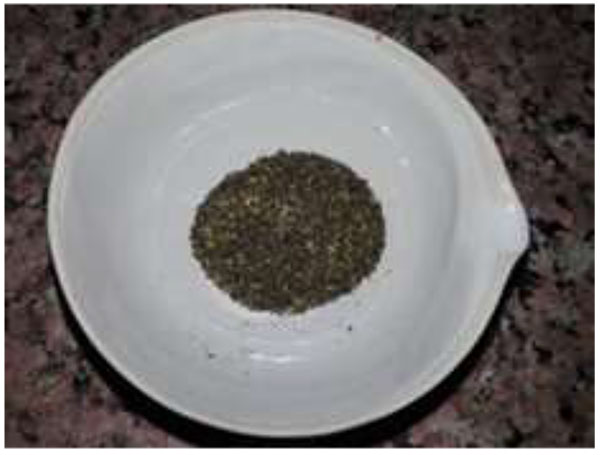
2.6. Saffron
Mainly consists of dried stigmas and upper parts of styles of plant known as Crocus sativus in Fig. (5), belonging to the family Iridaceae. It is rich in carotenoid glycosides, mainly containing terpenoids. It lightens the skin tone and provides fair and glowing skin [13].
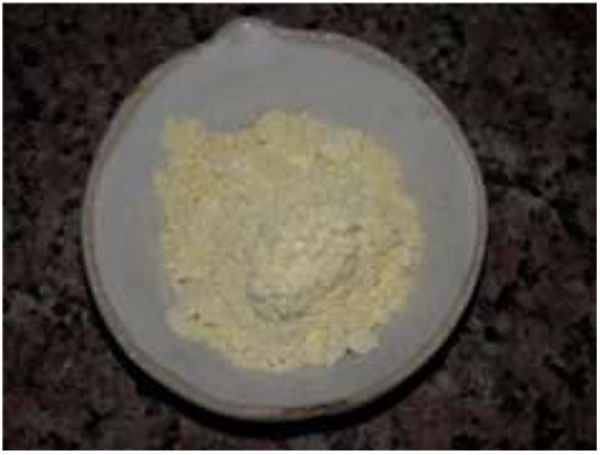
2.7. Milk Powder
It is very beneficial for skin, as it provides nourishment for dry, rough skin for the longer duration. Milk cream either in the form of powdered raw milk in Fig. (6) or milk as such provides a brilliant shine to skin. This is beneficial in hydrating the face deeply and makes skin youthful, lustrous and flawless. It bleaches the skin to remove dark spots, pigmentation, acne etc. This pack also removes blackheads, whiteheads, and other skin imperfections naturally. This facial pack helps in fading sun tan [14].

2.8. The composition of Face Pack
The powdered constituents were sieved using #40 mesh and mixed homogenously in Fig. (7) for uniform formulation. It was then kept in a moisture-proof container in a cool place for the purpose of standardization of various parameters [15-17] (Table 1).
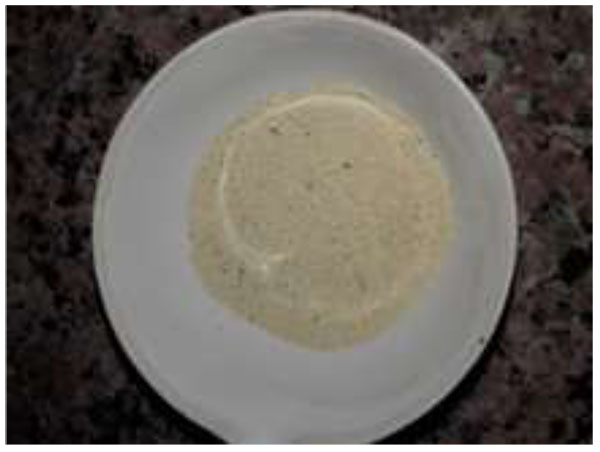
| S.No | Constituent | Percentage |
|---|---|---|
| 1. | Gram flour | 40 |
| 2. | Multani mitti | 20 |
| 3. | Shwet Chandan | 10 |
| 4. | Milk powder | 10 |
| 5. | Turmeric | 5 |
| 6. | Green tea | 10 |
| 7. | Saffron | 5 |
3. APPLICATION OF FACE PACK
The pack should be applied daily on wet face, forming a paste of it in water with optimum thickness. It should be applied evenly on the face with the help of a brush. It should be left for 15 minutes for complete drying. Then it should be removed with the help of a wet sponge.
4. USES OF FACE PACK
- Softens the skin, removes the dryness as it is rich in hydrating agents as milk powder.
- Brightens the skin tone due to the presence of shwet Chandan, turmeric, and saffron.
- Cleanses the skin, due to the presence of gram flour as it clears the skin by removing the dirt particles adhered to it.
- Clarifies the skin by fighting the problems of acne and blemishes, by the removal of excess oil from the face due to the presence of Multani mitti.
- Contains antiseptic action to deal with the minor cuts, marks due to the presence of turmeric.
- Exfoliates skin by removing the dead cells, which also prevents early aging due to the presence of green tea.
5. MORPHOLOGICAL EVALUATION
It refers to the evaluation of the pack by its color, odor, appearance, touch, etc. The external characters of the samples were examined based on the method described by Siddiqui et al [18] (Table 2).
| S.No | Parameter | Observation |
|---|---|---|
| 1. | Color | Pale yellow |
| 2. | Odor | Pleasant |
| 3. | Appearance | Smooth, fine |
6. PHYSICOCHEMICAL EVALUATION
Physicochemical parameters were determined, including the determination of extractive value, ash value, pH and moisture content [19] (Table 3).
| S.No | Parameter | Observation |
|---|---|---|
| 1. | L.O.D | 5% |
| 2. | pH | Neutral |
| 3. | Ash value | 4.5 |
| 4. | Extractive value(aq.) | 8.7 |
7. DETERMINATION OF RHEOLOGICAL PROPERTIES OF THE PREPARED PACK
Physical parameters like Untapped (Bulk) density, tapped density, the angle of repose, Hausner's ratio, and Carr's index were observed and calculated for the formulation. Bulk density refers to the adjustment of particles or granules to pack themselves collectively. The formula for determination of bulk density (D) is D = M/ V where M is the mass of particles and V the total volume occupied by them. The volume of packing can be determined in a graduated cylinder. 100 grams of weighed formulation powder was taken and slowly added to the cylinder with the aid of a funnel. The initial volume was observed firstly and the sample was then tapped until no further volume reduction occurred. The bulk density value was obtained from the initial volume and after tapping the volume reduced, from which tapped density was calculated. The angle of repose is used to quantify the flow properties of powder because it influences cohesion among the different particles. The fixed funnel cone method employs the calculation of height (H) above the glass paper that is placed on a flat tabular surface. The pack was carefully poured through the funnel till the peak of the conical heap just touched the tip of the funnel. Here, R denotes the radius of the conical heap, tan a = H/R or a = arc tan H/R, where ‘a’ is the angle of repose.Hausner's ratio is associated with interparticle friction and predicts powder flow properties. The Hausner's ratio is calculated as D /D' where D is the tapped density and D, the bulk density. Carr's index helps to measure powder flow from bulk density [20, 21] (Table 4).
| S.No | Parameter | Observation |
|---|---|---|
| 1. | Tapped density | 0.83 gm/ml |
| 2. | Untapped density | 0.58gm/ml |
| 3. | Angle of Repose | 150 |
| 4. | Hausner'sr ratio | 1.43 |
| 5. | Carr's index | 30.1% |
8. PHYTOCHEMICAL SCREENING
The aqueous extract of the herbal face pack was evaluated for the presence of different phytoconstituents as per the standard procedures [22] (Table 5).
| S.No | Phytoconstituents | Presence |
|---|---|---|
| 1. | Carbohydrates | + |
| 2. | Alkaloids | + |
| 3. | Glycosides | + |
| 4. | Tannins | - |
| 5. | Volatile oil | - |
9. IRRITANCY TEST
Mark an area (1sq.cm) on the dorsal surface of the left hand. Definite quantities of prepared face packs were applied to the specified area and time was noted. Irritancy, redness, and swelling were checked and reported for regular intervals up to 24 hours if any [23] (Table 7).
| S.No | Parameter | Observation |
|---|---|---|
| 1. | Irritation | - |
| 2. | Redness | - |
| 3. | Swelling | - |
10. STABILITY TEST
Stability testing of the prepared formulation was conducted by storing at different temperature conditions for the period of one month. The packed glass vials of formulation stored at different temperature conditions viz.., Room temperature and 35°C were evaluated for the physical parameters like Color, Odor, pH, texture, and smoothness [1] (Table 7).
| S.No | Parameter | Room temperature | 350C |
|---|---|---|---|
| 1. | Color | No change | No change |
| 2. | Odor | No change | No change |
| 3. | pH | 6.62 | 6.65 |
| 4. | Texture | fine | fine |
| 5. | Smoothness | smooth | smooth |
11. RESULTS
Organoleptic evaluation showed that the pack is smooth and pleasant smelling powder. Physicochemical parameters reflected that the moisture content was as minimal as 5%. pH was found neutral to suit the requirements of all the skin types. Ash value and extractive values were found within the limits. Rheological findings justified the flow properties of the pack as it was found to be free-flowing and non-sticky in nature. The results proved that the formulation was stable in all aspects. It is rich in the major phytoconstituents such as carbohydrates, alkaloids, and glycosides which act as true nourisher for the skin. Irritancy test showed negative results for irritancy, redness and swelling as the herbals in their natural form without addition of chemicals were found to be compatible with the skin proteins. Stability tests performed at different temperatures over a period of one month revealed the inert nature of the pack in the terms of color, odor, appearance, texture, and pH.
12. DISCUSSIONS
From the above observations, it has been notified that since the formulation is made up of naturally occurring dried herbal ingredients, there are almost negligible chances of the deterioration of the formulation, as there is no moisture containing the element in raw as well as processed form. The formulation was kept for one month at room temperature to observe the changes in its color, odor, texture and appearance. The pH was also noticed before and after one month. The formulation was found to be stable. It can be easily used at any temperature, at any place. Since it is a herbal formulation, it takes time to show the results. However, the use provides smooth and clear skin within 4-5 days. Its continuous use shows superb effects such as flawless, radiant and clear skin. Since natural ingredients are non-toxic, non-habit forming, they take time but remove the defects from roots. Since no chemical, preservative, artificial color or perfume has been added in the pack, the chances of its degradation are almost negligible. This leads to an increased shelf life with stable ingredients.
CONCLUSION
An herbal face pack is used to rejuvenate the muscles, maintain the elasticity of the skin, remove adhered dirt particles and improve the blood circulation. The benefits of herbal based cosmetics are their nontoxic nature. It nourishes the facial skin. This face pack supplies vital nourishment to the skin. It helps in the elimination of acne, pimple, scars, and marks. Face pack exfoliates skin and provides a soothing, calming and cooling effect on the skin. They restore the natural glow of skin in the optimum time period. Frequent uses of natural face packs improve skin texture and complexion. Pollution and harsh climates badly affect the skin and these effects can be countered by the regular usage of face packs. They help to retain the elasticity of skin cells, thereby controlling premature aging of the skin. Wrinkles, fine lines, and loosening of skin can be effectively controlled by using natural face. In this work, we found excellent properties of the face packs and further studies are needed to be performed to ascertain more useful benefits of face packs as cosmetics. Natural remedies are accepted nowadays with open hands as they are safer with fewer side effects than the chemical based products. Herbal formulations are required in large amounts to fulfill the needs of the growing world market. It is an effective attempt to formulate the herbal face pack containing different powders of different plants with multiple therapeutic benefits.
ETHICS APPROVAL AND CONSENT TO PARTICIPATE
Not applicable.
HUMAN AND ANIMAL RIGHTS
No Animals/Humans were used for studies that are base of this research.
CONSENT FOR PUBLICATION
Not applicable.
CONFLICT OF INTEREST
The authors declare no conflict of interest, financial or otherwise.
ACKNOWLEDGEMENTS
Declared none.


